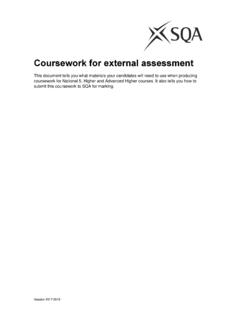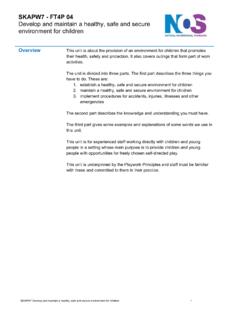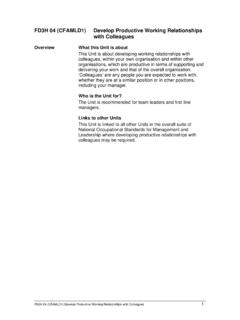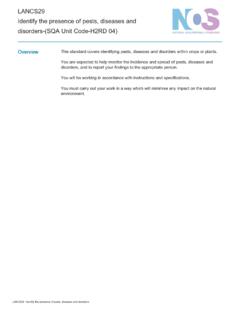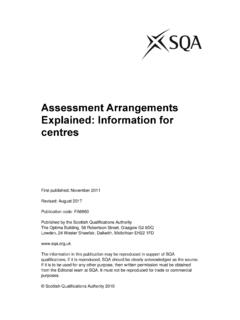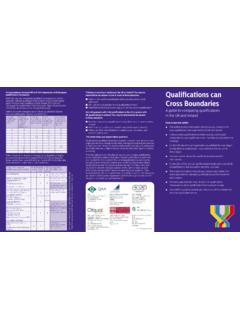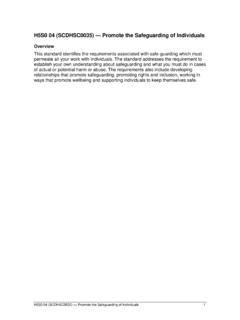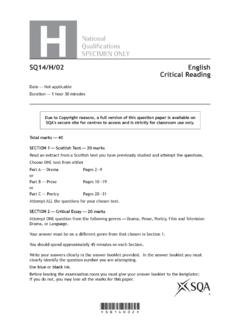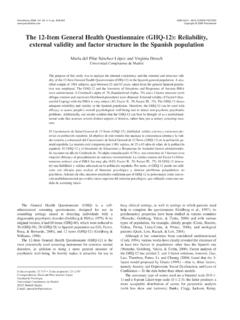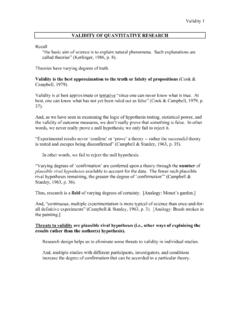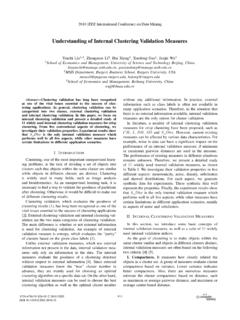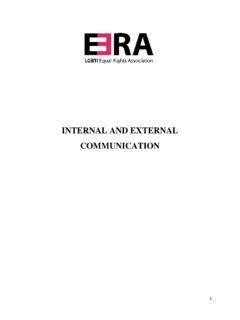Transcription of Internal verification: A guide for centres
1 Internal verification: A guide for centres Publication Date: March 2019 (Updated June 2019). Publication Code: AA7617. Published by the Scottish Qualifications Authority The Optima Building, 58 Robertson Street, Glasgow G2 8DQ. Lowden, 24 Wester Shawfair, Dalkeith, EH22 1FD. The information in this publication may be reproduced in support of SQA qualifications. If it is reproduced, SQA should be clearly acknowledged as the source. If it is to be used for any other purpose, written permission must be obtained from the Editorial Team at SQA. It must not be reproduced for trade or commercial purposes. Scottish Qualifications Authority For an up-to-date list of prices visit the Publication Sales and Downloads section of SQA's website. This document can be produced, on request, in alternative formats, including large type, Braille and numerous community languages.
2 For further details, telephone SQA's Customer Contact Centre on 0845 279 1000. SQA is committed to using plain English. We will try to make our publications as easy and straightforward to understand as we can, and will try to avoid all unnecessary jargon. If there's any language in this document that you feel is hard to understand, or could be improved, please write to Editor, Editorial Team, at the Glasgow address or e-mail: Contents About this guide 1. The purpose of Internal verification 2. Models of Internal verification 3. Centre responsibilities 3. Internal verifiers: qualifications and experience 4. Partnership arrangements and alternative assessment sites 6. SQA's responsibilities 6. Functions of Internal verification 6. Before assessment: supporting assessors 7.
3 Before assessment: checking assessments for validity , practicability, equity and fairness 7. Before and during assessment: ensuring reliability 8. Before assessment 8. During assessment: standardisation activities and sampling assessor judgements 9. During and after assessment: maintaining records 9. After assessment: reviewing Internal verification 11. Tools of Internal verification: standardisation and sampling 12. Standardisation 12. Sampling 13. Preparing for external verification 15. Glossary of terms 15. Appendix 1: Methods of assessment used by SQA 18. Appendix 2: Internal assessment appeals 19. About this guide Internal verification is a crucial element of SQA quality assurance. It ensures that all candidates entered for the same qualification are assessed fairly and consistently to the specified national standard.
4 This guide provides support for everyone involved in the quality assurance of internally- assessed qualifications. This includes all internally-assessed SQA qualifications and those qualifications offered by SQA which are regulated by SQA Accreditation, Ofqual and Qualification Wales. SQA's Governing Principles set out how SQA self-regulates its activities in relation to its own qualifications and those accredited or regulated by other organisations. The Principles are set out in our Awarding Body Code of Practice. While we hope that this guide will be of interest to all involved in assessment and quality assurance, it is particularly aimed toward: centres developing and operating their own Internal verification processes. SQA System Approvers and Verifiers considering centres ' documented Internal verification procedures.
5 SQA Qualification Approver and Verifiers considering the application of centres ' Internal verification procedures in specific subject areas. This guide complements the following SQA guidance documents: guide to Assessment Assessment: A guide for centres offering Regulated Qualifications Systems and Qualification Approval guide for centres guide to Systems Approval for Systems Approvers 2015 18. guide for Qualification Approvers 2015 18. guide to Systems Verification for centres 2015 18. Guidance on Qualifications Verification for Verifiers guide to Visiting HN and Vocational Qualification Verification 1. The purpose of Internal verification SQA must ensure that internally-assessed qualifications are credible with users, partner organisations, regulatory bodies and the wider community.
6 This requires an effective quality assurance system within centres and by SQA. Every SQA centre is responsible for operating an effective and documented Internal quality assurance system. This is an essential requirement for all SQA centres as is specified in SQA's Systems and Qualification Approval guide for centres . SQA is responsible for implementing an effective external quality assurance system to ensure that centres meet our requirements and qualifications provide national and internationally- recognised standards of attainment. This system is based on our principles of assessment, which state that all assessments must be: valid reliable practicable equitable and fair The purpose of Internal verification is to ensure that these principles are met. An effective Internal verification system will ensure that: valid assessments are used for each qualification all assessments are as accessible as possible while maintaining the national standards for the qualification assessments are capable of generating sufficient evidence to allow candidates to demonstrate that they have met the national standard for the qualification all assessors are familiar with the national standards and can apply them assessors reach accurate and consistent assessment judgements for the same qualification for all candidates in their centre in line with the national standard of the qualification Effective Internal verification also brings additional benefits to centres .
7 These include: facilitating collaboration between assessors and Internal verifiers, ensuring that standards are met across all assessment sites allowing quality concerns to be captured and addressed checking that record-keeping and resulting of candidates is accurate supporting preparation for successful external verification helping to protect assessors from challenges to their professional assessment judgements Effective Internal verification is an ongoing process. It allows good practice to be shared, and can help identify problems at an early stage. Leaving Internal verification to the end of the assessment process is poor practice and can jeopardise candidates' chances of gaining qualifications because there may not be sufficient time to carry out remediation or re- assessment.
8 Effective Internal verification involves planning and reviewing as well as actually carrying out verification activity. 2. Models of Internal verification There are many different ways of operating effective Internal verification processes. We have no wish to impose a particular system on centres , although all systems must meet our quality requirements that all assessors apply assessment standards uniformly and consistently. Please note that where the term Internal verifier' appears in this guide , it should be read merely as form of shorthand for any individual or team process by which the key objectives of Internal verification are met. centres should choose a model for the allocation and deployment of Internal verifiers that works in their situation and meets SQA's requirements.
9 There are several broad approaches, including: Allocating responsibility to named staff for carrying out Internal verification for particular units/awards. This has the advantage of giving the designated Internal verifiers a view of all assessments relating to the units/awards they are responsible for quality assuring. Allocating responsibility to named staff for carrying out Internal verification relating to particular assessors. This is particularly appropriate where the units/awards require a high degree of performance evidence, as is the case with many regulated qualifications. It makes good sense to use at least as part of your Internal verification approach . methods that gauge how assessors reach their judgements, by using dual assessment. All staff members taking responsibility for both assessing and internally verifying units.
10 This has the advantage of promoting in-depth understanding of the unit/award requirements and facilitating standardisation. Please note that under no circumstances can an Internal verifier verify assessments which they have developed, or verify their own assessment judgements. Centre responsibilities All SQA centres must document their Internal verification system. This must include information on all assessment sites, all qualifications offered, and all modes of delivery, including schedules and methodologies. This will allow all assessors and Internal verifiers to understand their centre's quality assurance process and their role within it. This document will be checked by our systems approvers and verifiers, and will also be used for reference by qualification approvers and verifiers.
